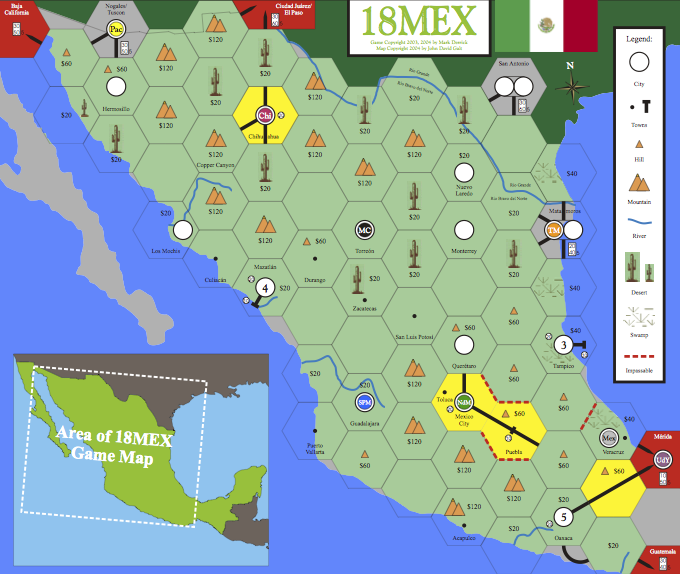At the core, the rules to 18MEX are very similar to those of 1830. What follows is a list of notable yet non-obvious differences to serve as refresher before play. If you are more detail-oriented, you can read the full rules or take a look at the summary created by BGG user Scott Petersen.
The Map
Set in Mexico, the map is obviously different from 1830. Worth noting is the cost associated with each hex. Most require an upgrade fee (for desert, river, mountain, etc.), which makes the initial bout of track-building more expensive even if you can place yellow track more quickly (see below).

Yellow Track Tiles and Dot Towns
Minor railroads may place one yellow track tile each operating round. Public corporations may place up to two yellow track tiles each operating round, or upgrade a single track tile (from yellow to green, or from green to brown).
Unlike in 1830, dot towns do not count against your train’s range even though they do increase your revenue.
Floating Initial Corporations
You need five shares to float a company (one less than in 1830). Take a look at my strategy section for the implications of this difference.
Purchasing Trains
When the game begins, each corporation is only allowed to purchase a single train per operating round. This changes as soon as the first 4-train is purchased, after which corporations may purchase as many trains as they like each turn.
To alleviate some of the train rush pressure, 4-trains do not rust immediately. Each corporation may use their 4-trains one last time after they become obsolete. Note this accommodation does not apply to any other type of train.
Diesel Trains
There are no equivalents in 1830 to the 4D trains in 18MEX. 4D trains have a maximum range of four; however, they double the revenue collected from each city (but not town) through which they pass.
Minor Railroads
The three minor railroads are a hybrid of private companies and public corporations. They are auctioned off like private companies, and have no share value. On the other hand, they have no special powers. They operate before public corporations, but in limited capacity. They can lay yellow track (never green or brown) and operate a single run; however, the revenue is always split 50-50 between the owner and the company. They cannot buy or sell trains, but do come with a free 2-train. All minor railroads close after the sale of the fifth 3-train, but become a share in the associated public corporation.
Mail Contracts
Free money! Any public corporation (not private or minor companies) that starts an operating round with a train (any train) receives money from the bank equal to the revenue value of its home station. In thematic terms, this income represents government mail contracts. All such income is placed in the corresponding corporate treasury and is never paid to shareholders.
NdM Merger
The National Railways of Mexico (NdM) represents a group of nationally owned railroads, but is owned as a sort of conglomerate by the players like any other corporation with the following significant exceptions:
To mirror the corporation’s historical development, no one may float the NdM in the first stock round, and no one may purchase its shares at all until Phase 3½.
After a player purchases the first 5-train, and if the NdM has floated, exactly one player may merge one of his corporations into the NdM. In broad strokes,* when and if a merger occurs:
Transfer all assets (trains, cash, and up to two tokens on the board) of the second corporation to the NdM.
The president of the second corporation trades his President’s Share for a 10% share in NdM. All other stock in the second corporation (from all players) is simultaneously sold to the bank for half the market price.
* See 5.3 of the full rules for additional details on the merger, including what happens if no one elects to initiate a merger.
Game End Conditions
18MEX ends a little quicker than 1830. In addition to a bank of only $9,000, the endgame conditions are more abrupt:
If the bank breaks, you only play out the current operating round (not the entire set). If the bank breaks during a stock round, then you play out a single operating round (again, not the entire set).
If a player goes bankrupt, then the game ends immediately.
Finally, there is an extra game end condition. If any stock reaches a value of $200 (the upper righthand corner), the game ends after the current operating round.
Track Upgrades
Tile upgrades in 18MEX are semi-restrictive. What does this mean? In 1830, a corporation need only reach the hex where it is placing a tile upgrade (permissive). In 18MEX, it must be able to reach some new piece of track on the new tile, or it must be able to reach a city on the new tile that has an increased value after the upgrade (semi-restrictive). Keep in mind, the corporation does not need a train that can actually run a route to the new track, but rather a hypothetical diesel that could.
In practice, this is a minor difference, especially to new 1830/18MEX players. If reading my explanation makes no sense to you, don’t worry about it! On the other hand, if you’d like to dig deep on the subject, take a look at the sections on tile replacement in the list of “1830 Clarifications.”